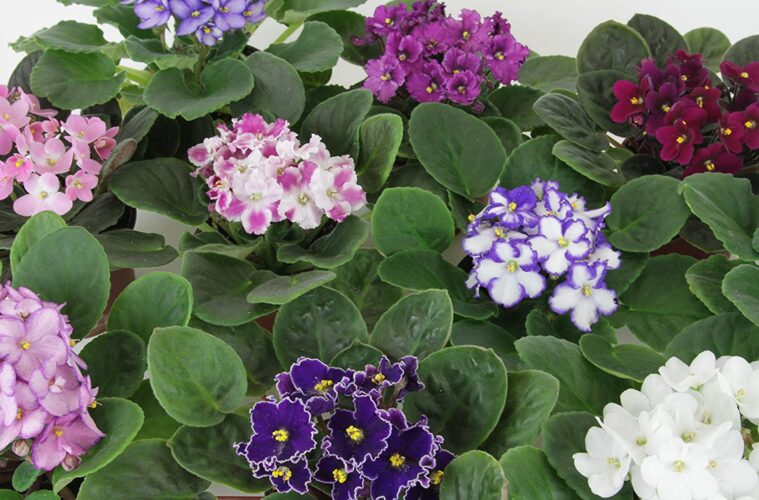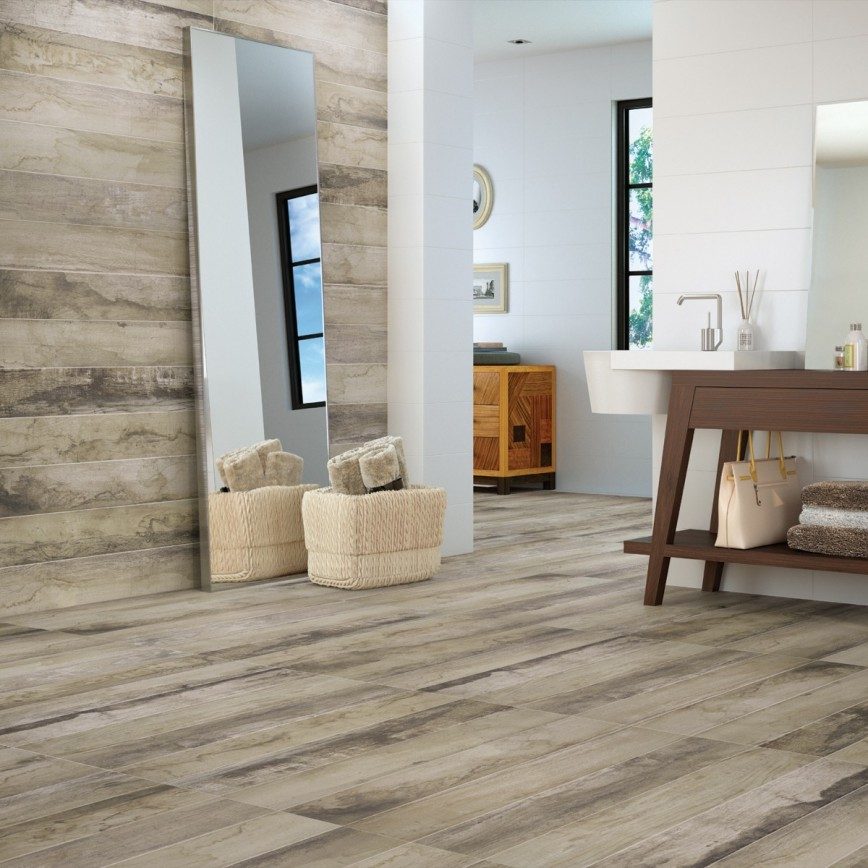While you’re spending extra time at home, you might be thinking about making some changes to your home’s decor. Indoor plants can provide both attractive design elements and healthy air filtration in your kitchen. Whether you’re a seasoned gardener looking for a few more potted plants or a first-time plant parent, there are plenty of options for bringing some greenery into your kitchen and dining area.
These plants take this into account, with options that can withstand a variety of light levels, humidity, temperature fluctuations, and more. There are also trailing and hanging options that can be placed on top of your cabinets and plants, such as herbs placed in your window or on the counter. Not to mention, there are a few plants that can help avoid any pest problems that might occur (goodbye flies!). These houseplants are a great place to start if you’re looking for an indoor plant for your kitchen.
Aloe-Vera
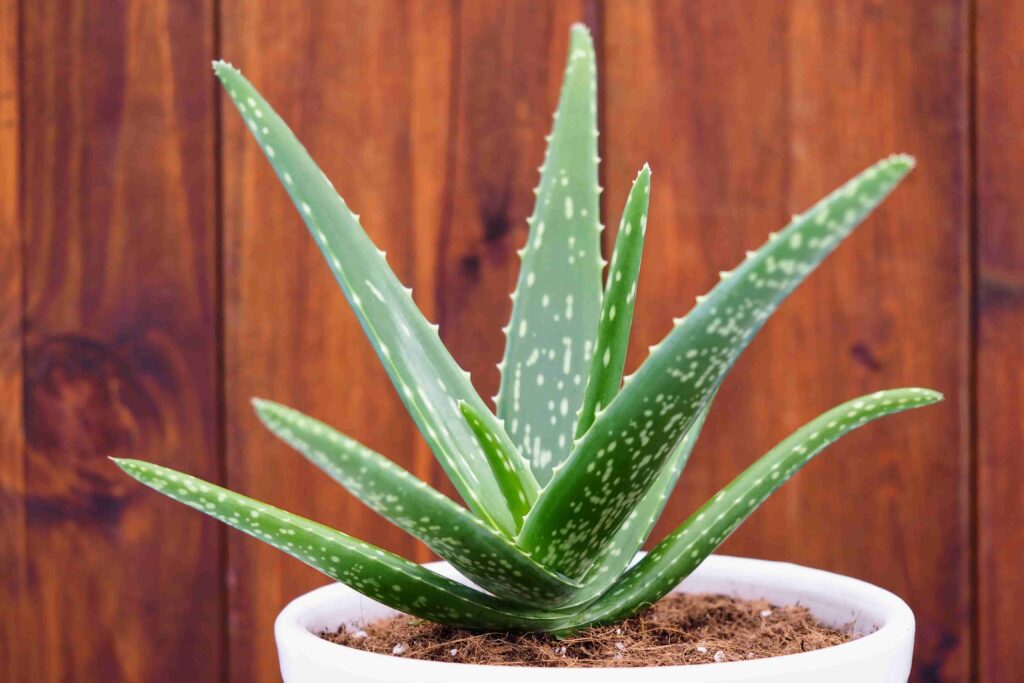
source: almanac.com
Aloe Vera gel is produced from the aloe plant’s leaves. It has been used to cure and soften the skin for thousands of years. Aloe has long been used as a folk remedy for many illnesses, including constipation and skin problems. Modern research into the benefits of aloe vera is mixed, with some data suggesting that it can cause cancer in lab animals.
Aloe vera, also known as the savior of sunburned skin, is classified into several types, including perennial, succulent, and xerophytic. Aloe plants can be grown both indoors and outdoors, which contributes to their adaptability and low maintenance. As a result, aloe vera has become a common household plant.
Many people keep aloe vera plants in their kitchens for decorative and medicinal purposes. Snapping an aloe leaf, splitting it open, and applying it to sunburned skin can fasten the healing process.
Gardening :
Botanical Name: Aloe barbadensis miller
Sun Exposure: you’ll need a location that offers bright, indirect sunlight.
Soil Type: Cactus or succulent soil mix
Soil ph: between 7.0 and 8.5
Common Ivy
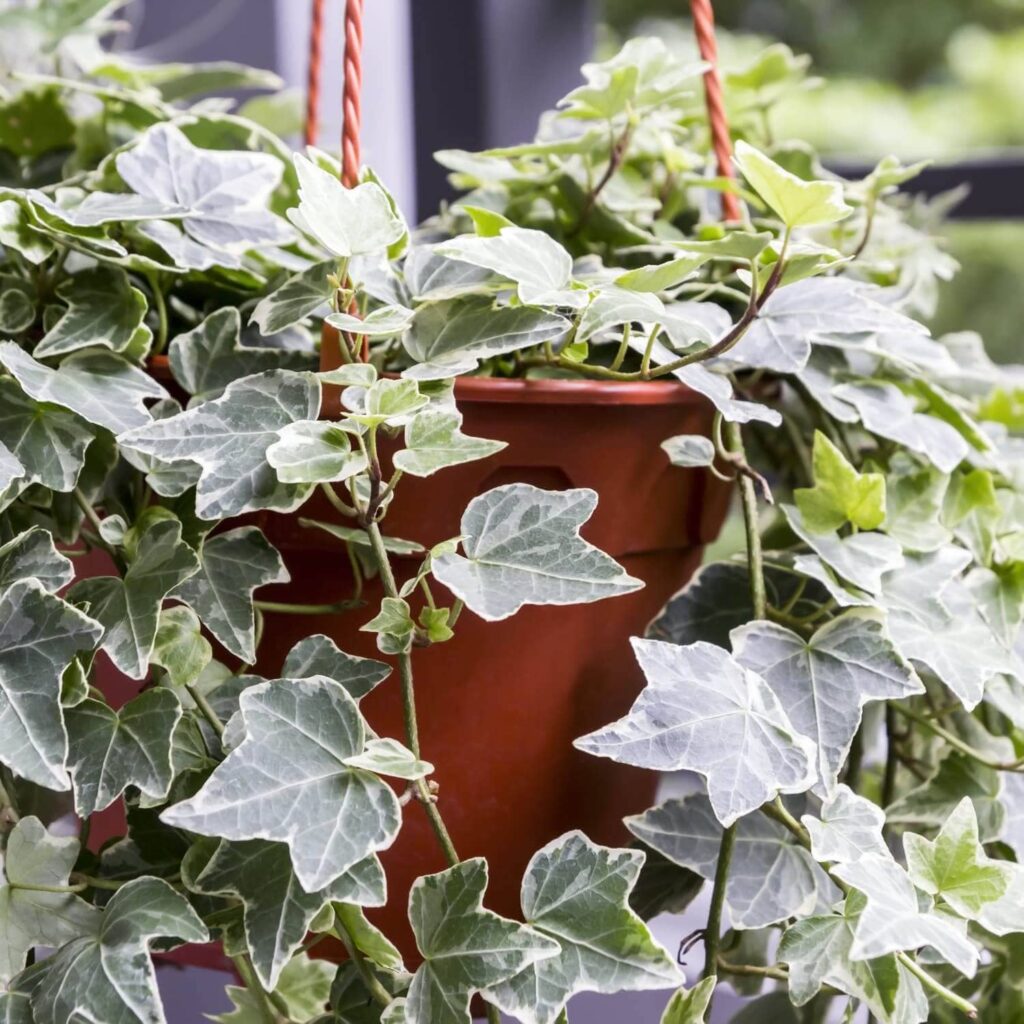
source: apartmenttherapy.info
English ivy, another naturally trailing specimen, adds a touch of stately charm to any room. To take full advantage, train its eager vines around a basket handle or hang it from a high shelf.
It’s adaptable to a wide range of lighting conditions, making it ideal for kitchens. Keep the soil moist (but not soggy) and spray the leaves often to prevent them from drying out. A good ivy plant will also help keep chemicals and mold spores out of your kitchen air.
Gardening :
Botanical Name: Hedera helix
Sun Exposure: Partial shade to bright, indirect light
Soil Type: Standard potting soil
Soil pH: 5.5 to 6.5
Pilea Peperomioides
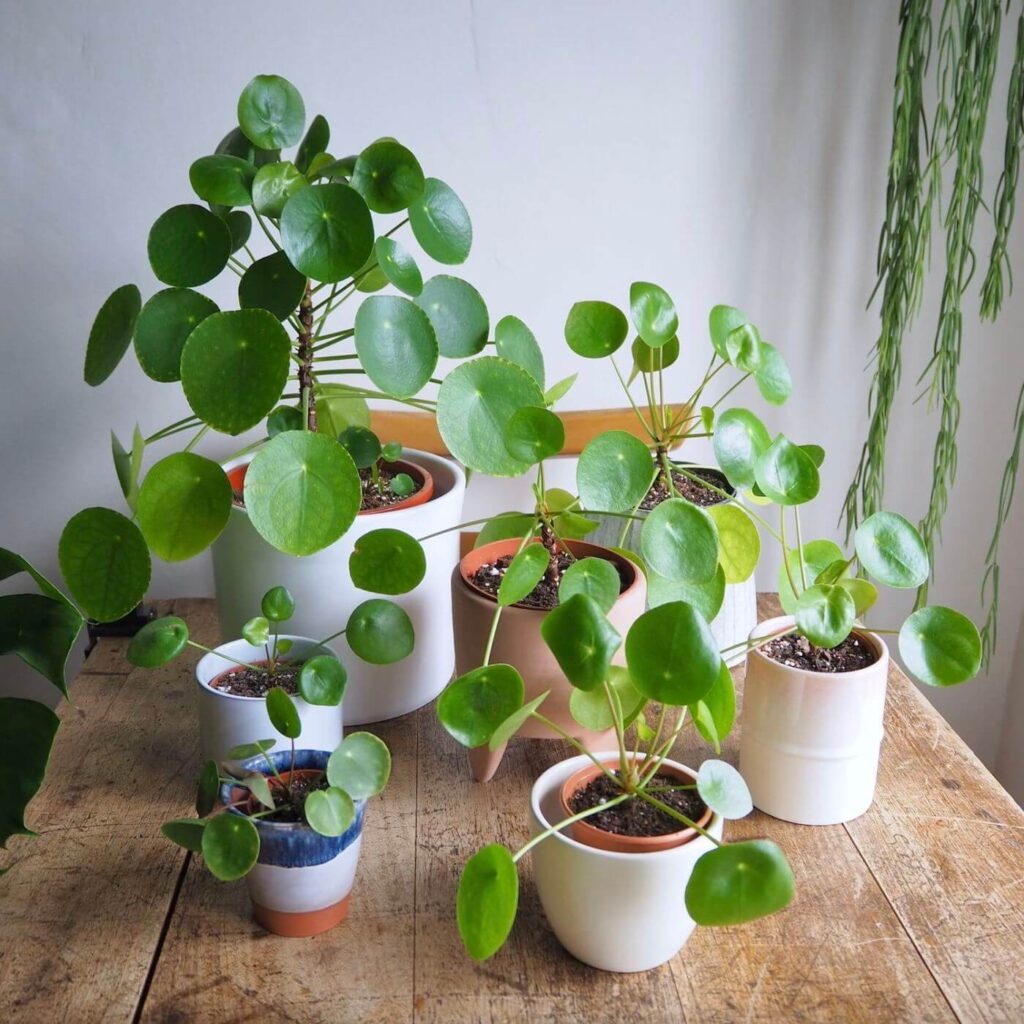
source: pinterest.com
This trendy, must-have houseplant is ideal for bright, sunny kitchens—and not just because one of its nicknames is the pancake plant! Pilea peperomioides need a lot of clear, indirect light to thrive, so place one on your brightest kitchen windowsill.
Keep an eye on its leaves; if you notice them curling, it means your pilea isn’t getting enough light and should be moved closer to the window or a brighter location. Remember to rotate your plant every week to ensure that all of its leaves grow and spread evenly.
Gardening :
Botanical Name: Pilea peperomioides
Sun Exposure: Bright, indirect light
Soil Type: Well-drained potting soil
Soil pH: 6.0 to 7.0
String-Of-Pearls
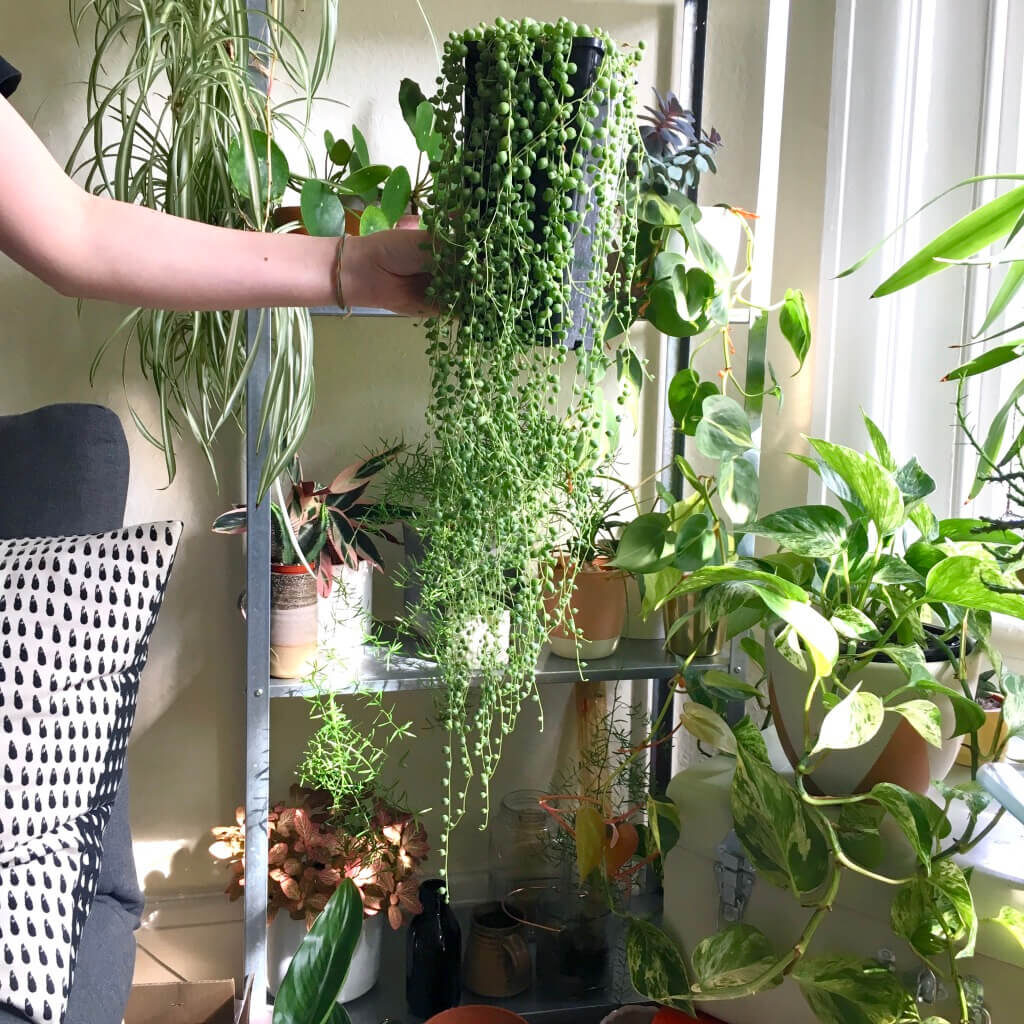
source: pinterest.com
This charming, elegant houseplant combines the best features of both a hanging plant and a succulent in one package. Its long, thin stems produce long strands of pea-sized “pearls” in an attractive green shade, and if you let it, the strings will grow to the ground as long as it’s happy.
The string of pearls looks great on a high shelf, the top of a cabinet, or in a hanging basket; make sure it’s in a place where it won’t be disrupted or jostled, as the pearls are easily broken. Overwatering this succulent would almost certainly result in root rot and the death of your plant.
Gardening :
Botanical Name: Senecio rowleyanus
Sun Exposure: Bright, indirect light
Soil Type: Well-draining cactus or succulent mix
Soil pH: 6.6 to 7.5
Cactus
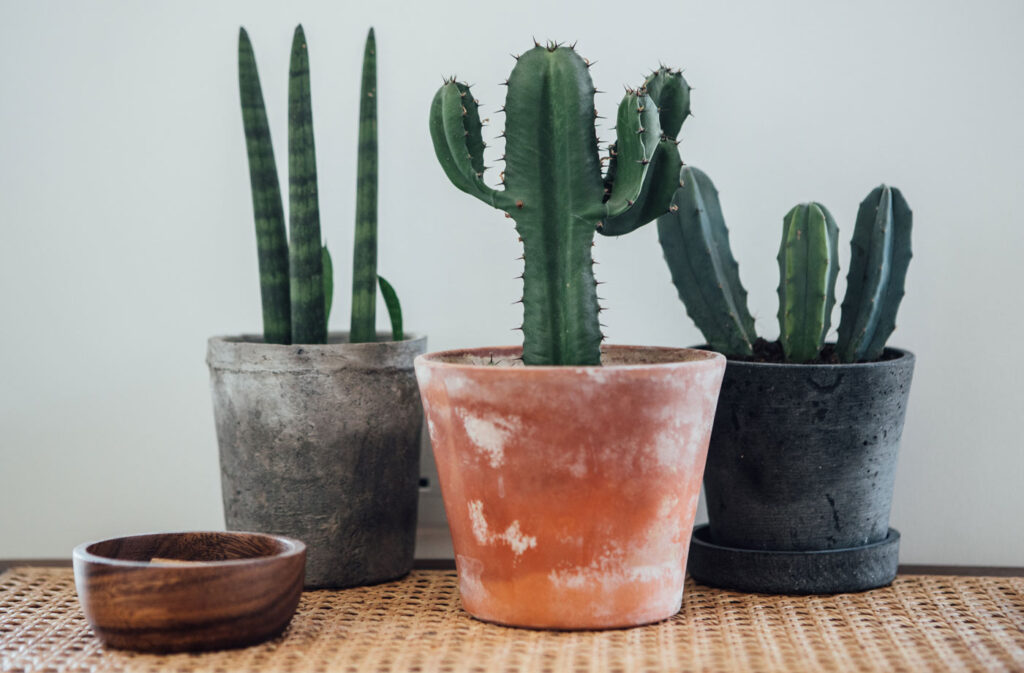
source: wellandgood.com
A cactus will add a touch of the Southwest to your kitchen, particularly if your kitchen is hot and dry. These spiny desert plants are relatives of succulents, and they, too, enjoy sunbathing. A cactus is a great option if you’re short on space but have a bright windowsill.
Cacti can survive without water for weeks at a time. Water every two to three months, but only if the soil is fully dry. To put it another way, if you’re a sloppy plant owner, this is the one for you.
Gardening :
Botanical Name: Cactaceae
Sun Exposure: Bright, indirect light to full sun
Soil Type: Fast-draining cactus mix
Soil pH: 5.5 to 6.5
Air Plants
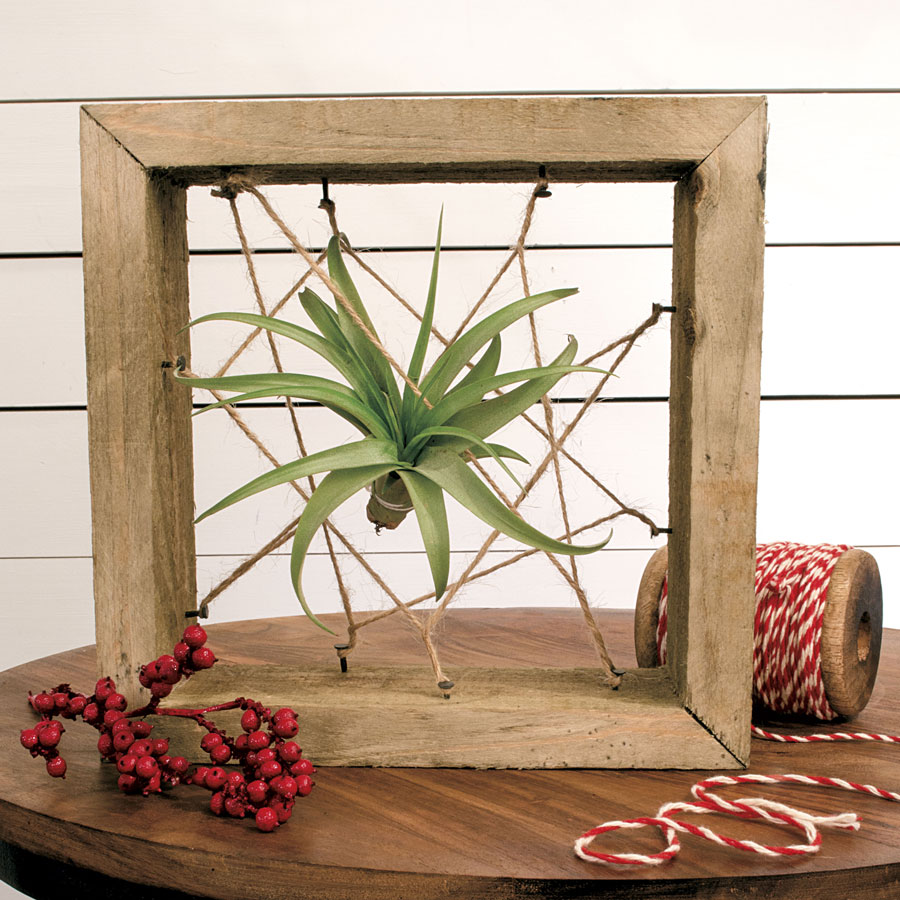
source: jacksonandperkins.com
All you need is a bright, sunny windowsill to view air plants, also known as Tillandsias. In reality, because they get their nutrients from the air rather than the soil, you can hold them in any warm place in your kitchen. You can organize plants on a windowsill, a plant stand, a decorative dish, or even suspended from the ceiling in a glass globe or framed on the wall—as long as they get plenty of bright, indirect light.
Bath your air plant every two weeks during the dry months of the year, drenching it in water for two to three hours before draining and letting it dry out again.
Gardening :
Botanical Name: Tillandsia
Sun Exposure: Bright, indirect light
Soil Type: Epiphytic
Soil pH: 4.0 to 8.0 (water pH)
Jade
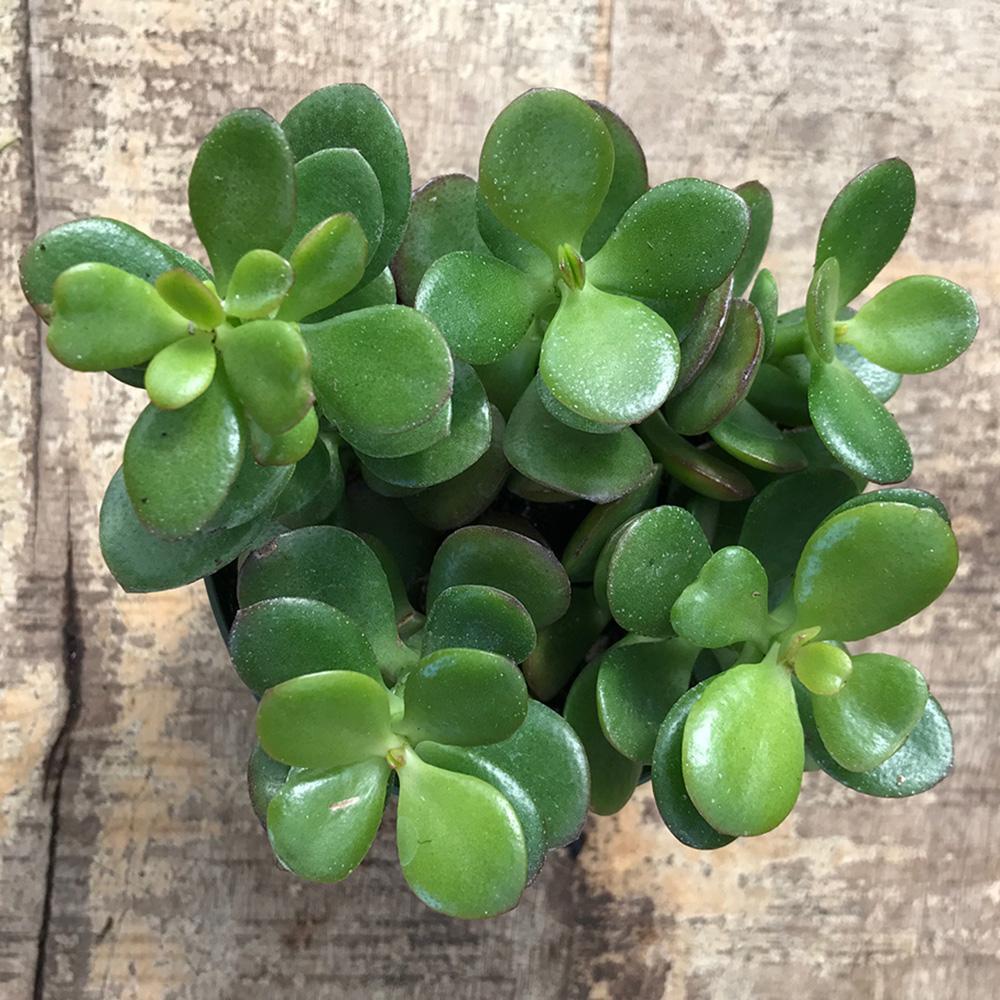
source: shopify.com
These adorable, versatile succulents can add a chic, desert-like vibe to any kitchen. They’re ideal for adorning a bright, sunny window that gets at least four hours of direct sunlight per day. While they can grow in low-light conditions, the signature red tinge on the edges of the green, paddle-shaped leaves will not appear without full sun.
If your kitchen is draughty in the winter, move your succulent back from the window a little, as jade plants thrive in temperatures between 50 and 70 degrees.
Gardening :
Botanical Name: Crassula ovata
Sun Exposure: Bright, indirect light
Soil Type: Cactus or succulent potting mix
Soil pH: 6.1 to 6.5
African Violet
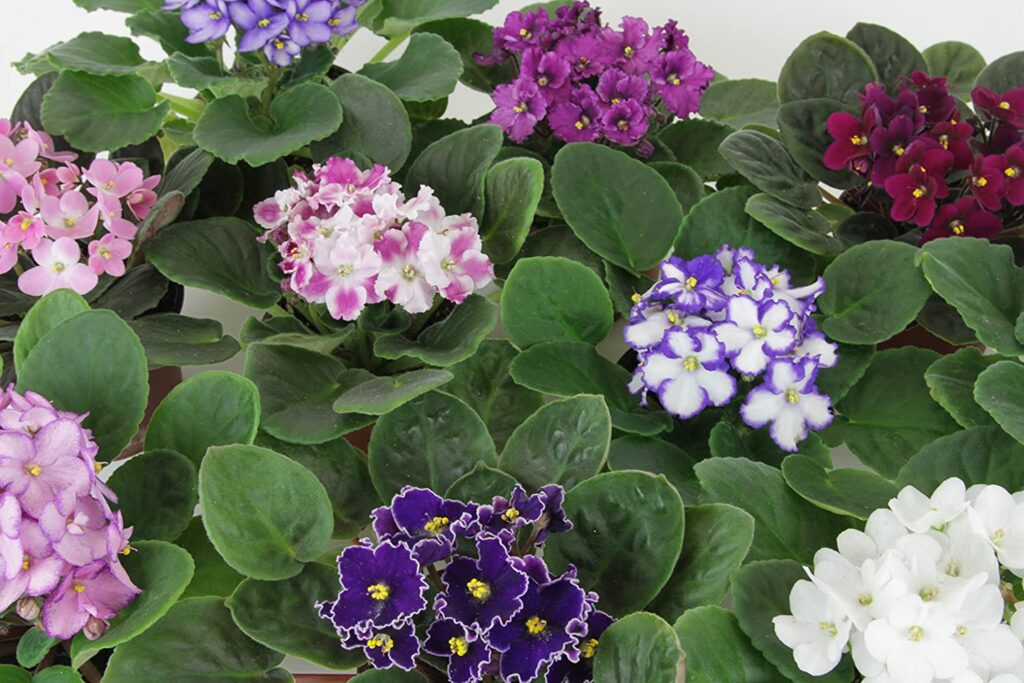
source: pinterest.com
If you’re looking for a splash of color, the African violet will provide it with its vivid blooms, which come in a range of pleasing purple shades and stick around all year. However, this plant will require more attention than some of the others on this list.
If you’re looking for a splash of color, the African violet will provide it with its vivid blooms, which come in a range of pleasing purple shades and stick around all year. However, this plant will require more attention than some of the others on this list.
Botanical Name: Saintpaulia ionantha
Sun Exposure: Bright, indirect light
Soil Type: Loose, porous, and well-draining potting soil
Soil pH: 5.8 to 6.2
Wandering Jew Plants
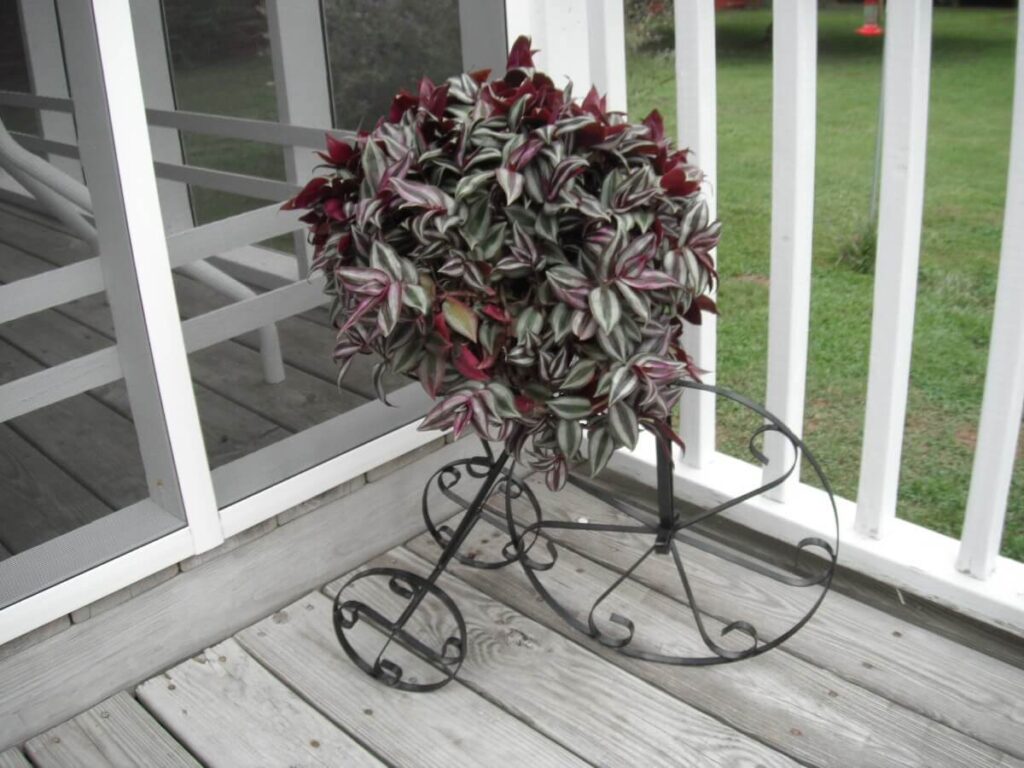
source: thrfun.com
The spiderwort family of Tradescantias and Zebrinas, also known as wandering Jew plants, are relatively easy to care for and can adapt to a wide range of environments.
Since its leaves are striped with vivid purple and silver, Tradescantia zebrina makes a striking addition to plants for kitchen collection; Tradescantia Padilla’s Purple Heart’ has slender, deep-purple leaves and stems, as well as small lilac-colored flowers.
Display yours near a kitchen window where it will receive plenty of clear, indirect light. Wandering Jew plants also make excellent hanging basket plants.
Botanical Name: Tradescantia
Sun Exposure: Medium to bright, indirect light
Soil Type: All-purpose potting soil
Soil pH: 6.1 to 7.8
Snake Plants
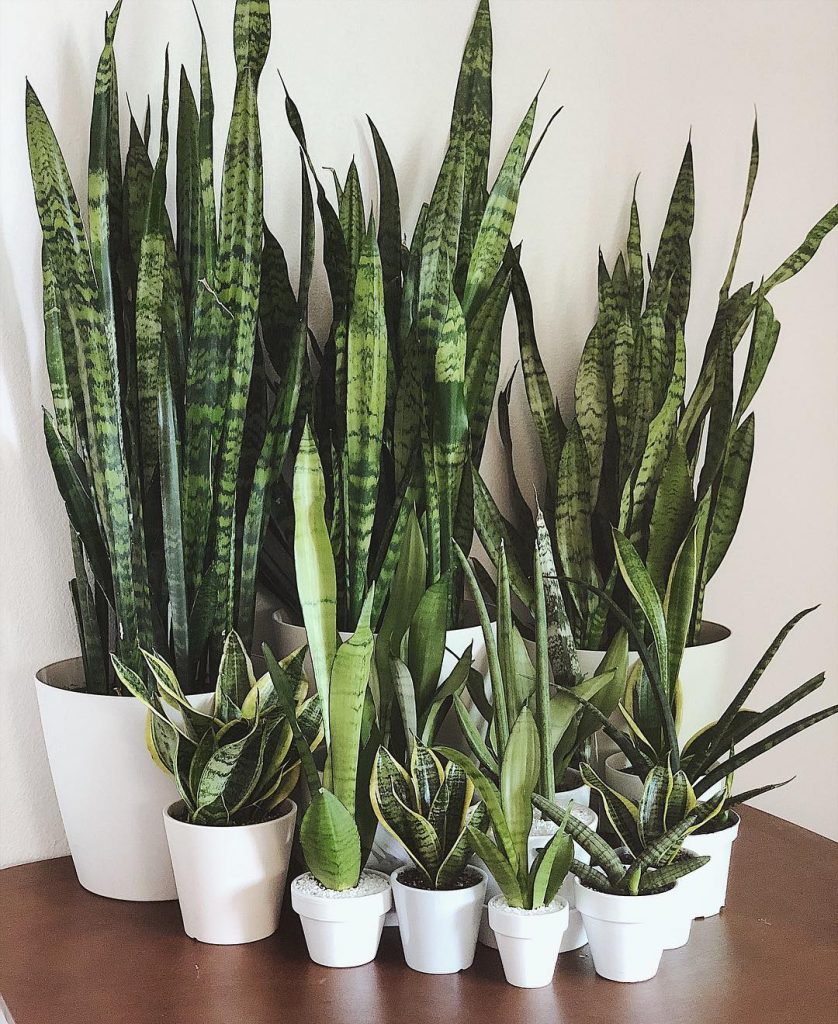
source: succulentcity.com
With its tall, vibrant, lance-shaped leaves, a snake plant is a perfect addition to a kitchen corner that requires some life, even if it isn’t filled with natural light.
As long as it has a little light and remains above a comfortable 65 degrees, the snake plant can go weeks without watering and even thrives when you forget about it.
Snake plants are also one of the most effective houseplants for removing harmful chemicals from the air.
Botanical Name: Sansevieria trifasciata
Sun Exposure: Low to bright, indirect light
Soil Type: Free-draining cactus or succulent mix
Soil pH: 4.5 to 7.0
Basil
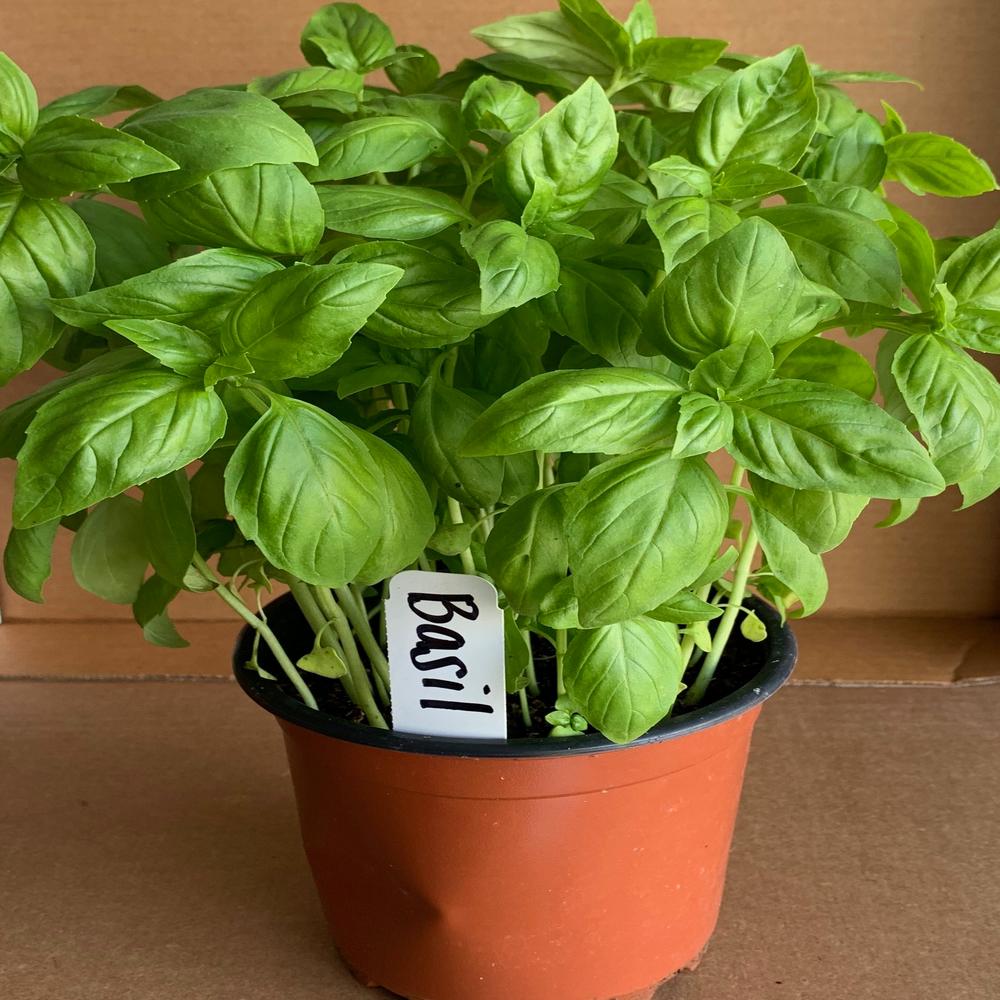
source: thdstatic.com
If your kitchen has enough light, fresh herbs are a no-brainer. Basil is one of the more straightforward herbs to cultivate, which is fortunate because it’s also one of the most versatile kitchens. And if you’re hot-tempered in the kitchen, you’ll be happy to know that the smell of basil is known to reduce feelings of stress and anxiety.
If your kitchen has enough light, fresh herbs are a no-brainer. Basil is one of the more straightforward herbs to cultivate, which is fortunate because it’s also one of the most versatile kitchens. Basil has also been shown to reduce tension and anxiety, which is good news if you’re a hothead in the kitchen.
Basil is one of those herbs that can be difficult to cultivate indoors. It needs at least six hours of bright light a day, as well as regularly moist soil. Pruning your basil plant stimulates growth while also supplying fresh leaves to elevate your dinners.
Botanical Name: Ocimum basilicum
Sun Exposure: Bright, indirect light to full sun
Soil Type: Herb or vegetable soil mix
Soil pH: 6.0 to 7.5

